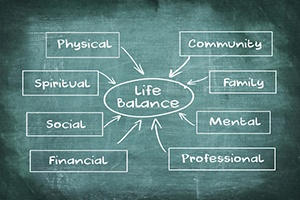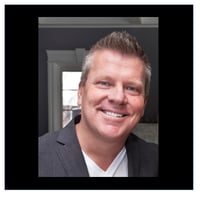Today we’re sharing insight from guest blogger Steve Richards, real estate entrepreneur. We hope you enjoy Steve’s wisdom and perspective.
 Life balance is something most people talk about, very few really understand and even less truly achieve.
Life balance is something most people talk about, very few really understand and even less truly achieve.
The biggest misconception about life balance is that most people think it’s something you do, but it’s really something that just happens.
It’s a result, not an activity.
The tough part about life balance is that it all starts with knowing what you want out of life, and that’s difficult for most people. A great process to go through on a quarterly basis for each aspect of your life is to ask yourself these four questions.
- What do I really want?
- What am I currently doing to get it?
- How’s that honestly working for me?
- What am I going to do next?
When answering these questions, be careful not to fall into the trap of broad thinking with answers like “I want to make more money.” That’s not really what you want if you’re honest with yourself. Digging another level deeper and saying it’s what the money can buy for me still probably isn’t good enough.
What that means is, it’s not the long European vacation, the sweet new pool in your backyard, or the exotic sports car you want either. At the core, what you probably want is to feel how you “THINK” all of those purchases are going to make you feel.
You probably really want the enjoyment of fulfilling family relationships, validation from your friends and neighbors that you are a great person, or the recognition from your team that your leadership provides great value to the company. When you distort your desire for happiness, success, and validation into wanting better job titles, vacations, and stuff – you start to lose sight of what really matters.
Therein lies a huge hurdle to achieving life balance. Many people don’t realize it, but they sabotage what they really want by chasing after what they think they want – and they may never learn the difference between the two.
Most people live in a constant state of conflict, but alignment is the key to true balance.
An example of conflicting goals is having goals to improve your marriage and become a great dad to your newborn child, and at the same time attempting to train for and run your first marathon while also taking on a job promotion that will require a lot of extra work hours. Pushing hard to achieve these conflicting goals at the same time doesn’t end well!
Chasing after competing goals is kind of like multitasking. Although we can do more than one thing at once, the reality is we cannot do multiple strategic things simultaneously very well. Of course, we can walk and talk at the same time, but if the conversation is deep enough – we may lose track of where we’re headed. We can also all drive and chew gum at the same time, but if we are using our cell phone while driving – watch out…
Studies show you are somewhere between 300 and 1000 times more likely to be involved in a car accident when driving while using your cell phone. I’m not sure if anyone is studying this, but the stats must be similar where you are significantly less likely to achieve one goal when distracted by a different conflicting goal.
Now why does a cell phone distract driving so much when looking at mirrors, checking the speedometer, or even messing with turn signals and windshield wipers doesn't cause the same issues? The reason is that all the aforementioned items are aligned with the overarching objective to help you get to where you are going as safely as possible. Although you could be distracted by any of those items, the fact is that since they are all working for the same general result – any distraction they cause is outweighed by the benefits of working in unison to achieve a goal.
The same can be said for your various goals. If your spiritual, family, health, financial, career, and personal goals have all been set in harmony with one another, the benefits of having synergy in each aspect of your life will set you on the path to life balance.
Similarly, getting your team to all row in the same direction not only eliminates friction, but more importantly manufactures momentum - and the difference between friction and momentum is the difference between failure and success or frustration and happiness.
Remember, knowing what you really want in each area of your life is the first step in creating life balance. It will give you (and your team, family, neighbors, friends, church community, etc.) the ability to create synergistic goals. Once you do that, rather than competing and conflicting with each other - your goals will begin to work in unison with one another.
What’s The Risk?
I once heard Joel Osteen say the greatest lost treasures in life aren’t sitting at the bottom of the ocean in sunken ships or tucked away safely in the hallways of museums, but rather buried in cemeteries as missed opportunities, unfulfilled dreams, and unrealized successes. Not living up to your potential personally, as well as not being able to teach, inspire, and support those around you to do the same could leave you sad, disappointed, and with regret later in life.
Call it life balance, happiness, success, or whatever…What we are talking about here is clarity and continuity, and knowing what you really want in all aspects of your life and understanding how to go after it! As leaders, the only more important thing we can do outside of implementing life balance in our own lives is to pass along the gift of understanding how to achieve balance to others in our lives who we lead and love.
Remember, life balance is a result – not an activity. First strive for continuity and authenticity among the goals in the various aspects of your life, and you won’t have far to look for life balance – because it will find you.
This content was written and shared by guest blogger Steve Richards.
 After earning a Business degree from Ball State University, Steve Richards went to work in corporate America for Electronic Data Systems (EDS) – one of the world’s largest international technology consulting firms at the time. Over the next several years, Steve climbed the corporate ladder, and learned a lot about how businesses operate, automate their processes, and scale their revenue. After helping many businesses get started and accelerate their growth (especially during the dotcom run at the end of the 1990’s) as a consultant, Steve was bitten by the “entrepreneurial bug.” He started investing in real estate in 2004, and within six months made a bold move to step away from his career to pursue his real estate business full-time. After ten years in the business, he had started and grown three different companies focused on acquiring, renovating, and managing rental properties and had completed several hundred transactions.
After earning a Business degree from Ball State University, Steve Richards went to work in corporate America for Electronic Data Systems (EDS) – one of the world’s largest international technology consulting firms at the time. Over the next several years, Steve climbed the corporate ladder, and learned a lot about how businesses operate, automate their processes, and scale their revenue. After helping many businesses get started and accelerate their growth (especially during the dotcom run at the end of the 1990’s) as a consultant, Steve was bitten by the “entrepreneurial bug.” He started investing in real estate in 2004, and within six months made a bold move to step away from his career to pursue his real estate business full-time. After ten years in the business, he had started and grown three different companies focused on acquiring, renovating, and managing rental properties and had completed several hundred transactions.
In 2014, Steve realized he had built a business designed around chasing opportunities, rather than serving through his true purpose in life – which is to create impact and opportunity. It wasn’t an easy road, but Steve was able to radically redefine how he does real estate. He now has created a lifestyle business that is both scalable and consistent, but also allows him to focus on his strengths and provide value to others through his unique abilities. Steve, his wife Katie, daughter, and twin boys currently reside in Fishers, IN. Outside of family, church, and business, Steve invests time into his community. He is currently the President of the Fall Creek Township Board of Zoning Appeals, and sits on the Fishers Plan Commission.



